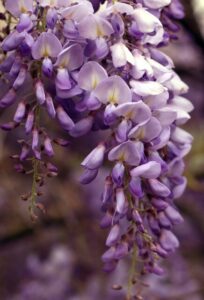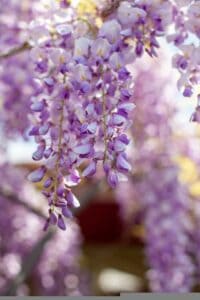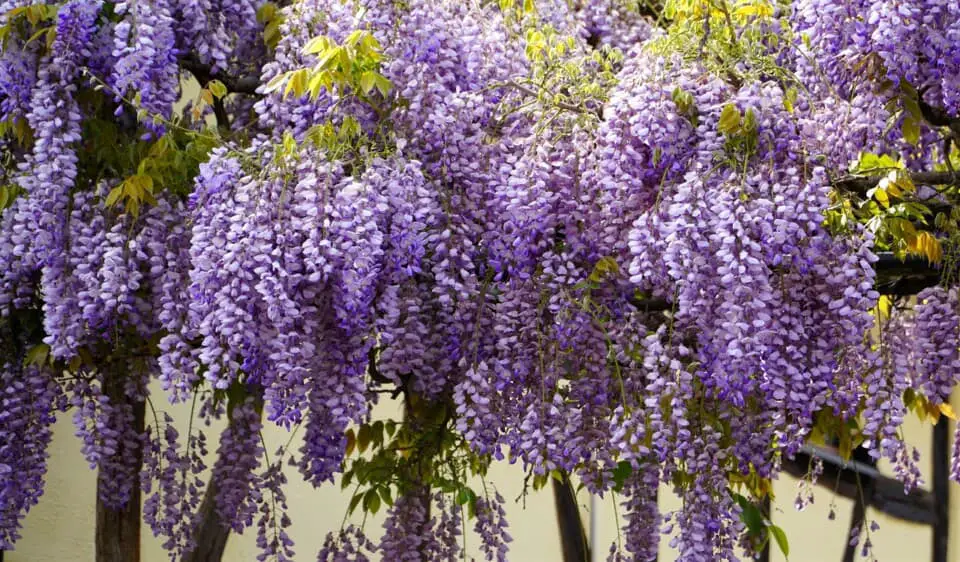Some links in the post are affiliate links and I get a commission from purchases made through some links found in the post.
Wisteria is a great plant to have due to its deciduous and perennial vines. It grows 25ft to 35ft in length and grows or spreads randomly or can be trained to your liking.
It thrives in well draining soil. May is the month that is considered blooming time for wisteria but it depends on hardiness zone you live in. Wisteria likes mild to neutral acidic pH soil and it prefers the soil to be moist.
A wisteria has great benefits such as adding nutrients to the soil. It also provides a decorative as well as fragrant atmosphere. It is also used in medicines and paper making. Moreover, the petals of flowers are used in both drinks and food.
There are mainly three varieties of wisteria; American wisteria, Japanese wisteria, and Chinese.
All of them have a fast growth rate and look similar to each other. A wisteria has a habitat of climbing over trees and cliffs, that’s why it is used in pergola covering.
Let’s unlock all the benefits of wisteria in detail.
What are the Benefits of a Wisteria?
The benefits of a wisteria depend on the way of using it. Moreover, due to the different varieties or kinds of wisteria, its benefits also vary.
Wisteria modifies the exterior décor of your home/garden. It also gives you an enchanting ambiance with an exceptional aroma. Let’s find out these benefits in detail.
1) Covering for Pergola
 A wisteria has many benefits but it’s premium is it’s use as shade. It is no doubt that wisteria has an ornate attraction with the long and dark vines and its shiny and lustrous leaves complementing a sitting area of the garden or lawn.
A wisteria has many benefits but it’s premium is it’s use as shade. It is no doubt that wisteria has an ornate attraction with the long and dark vines and its shiny and lustrous leaves complementing a sitting area of the garden or lawn.
Wisteria provides you with complete shade by beautifying the pergola. Firstly, it gives you shade from the sun, and it adds pleasing air around you.
Moreover, it is not a tough plant to grow. It effortlessly brands its way up and wraps around the given metal. The internal mechanism of the wisteria designs systematically stems around the pergola surfaces.
Its pink, purple, red, and white flowers offer praise to the space.
You may also like: The common problems with a wisteria & how to fix them
2) Nitrogen Fixer
A wisteria contains nitrogen-fixing legumes. It has developed this due to its habitat and origin.
Wisteria encompasses nitrogen-fixing legumes indicating that the microorganisms around the roots of the wisteria perform a function in which it converts the nitrogen into beneficial nutrients.
These nutrients ultimately reach up to the needs of the plant, helping the wisteria to grow faster and have a healthy outlook.
Apart from this, these nutrients also help the soil to maintain strong. In this way, it also reduces the amount of fertilizer you need to add, that being said you will still need to add some seasonally.
On the contrary, the excess amount of nitrogen may affect the growth of the wisteria leaves negatively or there are chances that a large number of nutrients in the soil may affect the nearest plants but these are the very rare cases.
But you can control it by monitoring the quantity of fertilizer.
You may also like: Wisteria light requirements
3) Easy Vine Grower
A wisteria is a very fast grower, it can grow up to 10 feet in a single growing season. This makes it great to have in a newly established garden to fill in your unwanted gaps.
Due to it’s incredible growing speed and fast climbing it is really easy to propagate and take care of.
When in the growing season, make sure you train the wisteria into the shape you would like it else it could get out of hand.
4) Sensational Odor
A Wisteria’s fragrance is indeed incomparable. It includes a pleasing aroma around you.
A wisteria plant of 25 feet long or mature wisteria can cover a small garden easily with its smell. A few varieties of wisteria have mild fragrances while others have a strong sweet odor.
Apart from adding fragrance to your garden, wisteria benefits you by allowing you to create a natural scent for yourself as well.
Wisteria flowers, particularly its petals, have all the strength to carry phenomenal fragrance in them. All you have to do is collect wisteria flowers in a bucket depending on how much you’re making and make wisteria oil.
It is recommended to collect flowers in the middle of the blooming season which is around mid-May.
After creating a wisteria oil, you can mix it to create a homemade soap or a homemade massage cream to get get that beautiful piece of your garden in your home.
It is favorable not to use wisteria oil directly to your face or around your mouth. Even though the petals of a wisteria are non-toxic, you need need to be careful with it if you have sensitive skin.
You may also like: How long does wisteria bloom for
5) Edible Wisteria
 A interesting benefit of the wisteria is that it is edible. It can beautify your food and be nice to consume if you consume the right part. The most regular and common varieties of which are eaten are the Chinese and Japanese wisteria.
A interesting benefit of the wisteria is that it is edible. It can beautify your food and be nice to consume if you consume the right part. The most regular and common varieties of which are eaten are the Chinese and Japanese wisteria.
The flowers/petals of these varieties allow you to use them in your food, drinks, or as a tea substitute.
But be careful as the wisteria seeds and pods are toxic to pets and humans. Whether it’s taken in large amounts or in small amounts, it can cause oral infection, vomiting, and many other severe problems.
Sometimes it takes two to three days for children to recover but sometimes it takes more time.
6) Made Into Paper
Moreover, a wisteria can also be made into paper. But wisteria stem has a specific fiber that is helpful for paper making.
The procedure is a little different compared to the regular way of making paper. So, despite being a toxic stem of wisteria, it can still be done.
You may also like: Why are your wisteria leaves turning yellow and wisteria vs lilac
Final Thoughts
A wisteria has a range of benefits and they completely depend on the process or system you are using it. A wisteria can be used as only a plant or you can use it to create many useful things.
Apart from all these benefits, wisteria is an easy-going plant. It doesn’t depart from you in a year or two, it comes with a long-life span.
It can live up to fifty years. Moreover, it requires very little attention and care. But it grows faster compared to the other plants.
Due to this factor, once established a wisteria’s stem is very strong and if you did ever plan to take it down, it can be difficult.
Wisteria is very simple to propagate and harvest in any soil. It doesn’t require much attention but in the case of pets and children, you need to keep an eye on it.
You may also like: Wisteria tree vs vine


